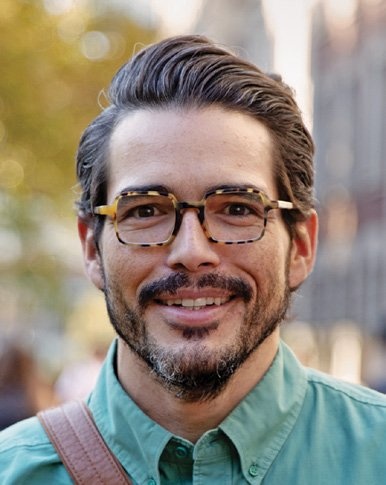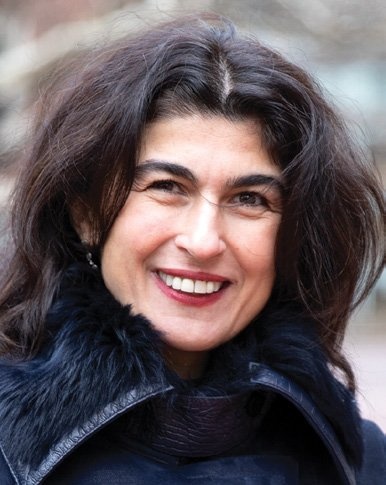We ask five professors what it’s like to teach the Core today.
Columbia College | Columbia University in the City of New York
We ask five professors what it’s like to teach the Core today.
The Core Curriculum has been the cornerstone of a Columbia College education since its inception in 1919. This past fall we launched the online series “Core Conversations”; each month we speak with a Core instructor to learn what they love about engaging with College students. The series has allowed us to hear firsthand what the curriculum means to the professors and lecturers who are guiding the latest generation, along with how they’re evolving their approaches to suit the world today. Read on for a sampling of what they had to say; check out the full interviews at college.columbia.edu.

Photographs by Emma Asher
For me it’s more the question of, “What was your most significant teaching moment?” I was teaching Lit Hum when the Covid-19 pandemic reached New York City in spring 2020, and we were all sent home. One of the texts that we were reading was Dostoevsky’s Notes from Underground. The descriptions and comments on society, while trapped inside, were very poignant. Not just for the students, but also for me — teaching classes from my dining room table, having hastily taken my books and my desktop computer from my office in the middle of the night. My students were scattered around the country, and sometimes around the world, Zooming into classes in sometimes difficult circumstances. It was striking to have a text that describes social isolation so powerfully. I think that was quite pertinent to all of us and offered a vehicle to think about those issues with a little bit of remove.
That’s one of the nice things about Lit Hum. We’re faced with very big and important questions about what it is to be a human being and what the good life for human beings might be. But we’re also given the space to engage with them not in a purely practical way, thinking through other people’s answers to those questions and how that might relate to our own context but not, precisely, in order to change things; although I think a lot of students find that they’re changed by the course — and I certainly find myself changed by teaching it — but in unexpected ways, without an agenda, without a program. So that’s one example of a thing that I think happens in less dramatic ways all the time — at least if the class is going well.

It’s two things for me. First, it gives me access to a pool of students that I would not have access to if I were only teaching in my own department. One of the things that’s so powerful about the Core is having a learning community of students from different backgrounds and interests; it is really powerful in terms of the ways in which you can approach and analyze the texts. It creates an incredible learning dynamic for the students, and for me as well. I think that’s something that you can really only get in these kinds of classes.
The second thing is that teaching the Core also gives me access to a generation that’s different from my own and allows me to better understand the ways in which that generation approaches opportunities and challenges and possibilities. As I teach the Core again and again, I have started to see some generational variations within students that I find very illuminating.

One of the defining features of music as an art form is the communal way in which we experience it. Put differently, many pieces of music depend not simply on the interaction of a creator and a solitary consumer, but also on this broader triangulation of author, performers and audience. So the highlight of the semester for me is almost always the trip to the Metropolitan Opera. With hundreds of students in attendance, Columbia basically stages a takeover of the top rungs of the theater to see Puccini’s La bohème or Verdi’s La traviata or, recently, Blanchard’s Champion. This is a fun social occasion, but also an opportunity to reflect on what it means to share an artistic experience in real time and in person with those around us. We will have watched a recording of the opera in question in advance of the performance. Students have very smart observations about the differences between the live and the digitized version of the work, and the trade-offs between accessibility and immersion raised through these diverse means of consuming music. And I think — especially coming out of years of schooling impacted by the pandemic — taking in this massive musical spectacle in a packed house and in our best fancy outfits is not something we take for granted.

I think that in the world that we live in, it is very important for people to be scientifically literate; for people to be able to think for themselves when they’re given a piece of information. To ask, “How do I evaluate this information? How do I know where to go and find the data that will tell me this is how it really works?” And it’s even more important now that we have information coming from all sides, whether it’s created by humans or by artificial intelligence. The world is becoming more complex and, as such, we have to teach students to think in an even more complex way — to take in interconnected issues as a whole, but also to know how to break them down.
We do not presume that a student will learn all science in one semester of Frontiers of Science; this is not our goal. But by giving them a sampling of how scientists from all disciplines think and how they approach the world and what tools they use in order to understand it? I think that is very valuable. The goal of Frontiers of Science is to teach students how to become good consumers of science, and how to become good critical thinkers using the scientific method. So the idea is that we’ll give all these scientific building blocks we have at our disposal, which then they will apply to their own lives.

The official title of the class is “Art Humanities: Masterpieces of Western Art,” and I think we’re all aware of the potential problems with certain wordings in that title. My Ph.D. is in medieval East Asian art. So whenever possible I try to bring in pieces from East Asia — mostly Chinese, Japanese and Korean — and start things off by asking the students to contrast and compare objects from that part of the world with some works that we cover in Art Hum. Oftentimes, that juxtaposition spurs different kinds of conversations that are quite illuminating.
For example, I teach Raphael in relation to the one-point linear perspective and how that transformed visuality to emphasize a rational organization of illusionistic pictorial space in Renaissance Italy. I bring in scenes from a 12th-century Japanese hand scroll, The Tale of Genji, and put them side by side with, say, The Marriage of the Virgin or The School of Athens, and then I ask the students to make sense of the 12th-century Japanese artists’ rather different approach to the construction of pictorial space, and how that might have served the pictorial purpose just as eloquently. By doing this, the students become aware that the one-point linear perspective is one among various systems of organizing pictorial space. So that’s my way of expanding, if you will, the periphery of “Western art” as defined in Art Hum.

Published three times a year by Columbia College for alumni, students, faculty, parents and friends.
Columbia Alumni Center
622 W. 113th St., MC 4530, 4th Fl.
New York, NY 10025
212-851-7852
cct@columbia.edu

Columbia Alumni Center
622 W. 113th St., MC 4530, 4th Fl.
New York, NY 10025
212-851-7488
ccalumni@columbia.edu